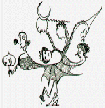 |
ANTIQUE BOXES
at the Sign of the Hygra
2 Middleton Road
London E8 4BL
Tel: 00 44 (0)20 7254 7074
email: boxes@hygra.com |
Antique Boxes in English Society
1760 -1900
by ANTIGONE
Tea Caddies and Tea
|
|
| News | Buying
| Contact us
| Online History of boxes
| The Schiffer Book | Advanced
Search |
| Rare 18th Century walnut Tea
Chest Fitted with a Secret Compartment, Circa 1780. |
A late 18th century walnut veneered tea chest fitted with three lift out tin plated canisters
and having a secret compartment with a drawer. Circa 1780.
Although of traditional form
this chest has many unusual features mark it out as special and
rare.
The secret drawer is accessed by
sliding up one of the sides.
The central panels of well
figured walnut are fielded by an inlay with a chequer design
framed by a cross banding of further walnut.
For the most part the chest carcass-work
is
made with quartered oak. The molding surrounding the chest is the
traditional "caddy molding".
The whole piece is particularly
finely made and is in very good original condition
|

|
|
|
The chest has a central brass
handle and brass escutcheon.
The chest is stamped twice to
the underside with "HP"
The chest has a working lock and
key.
It measures 10.25 inches wide
by 6 inches deep and it is 4.25 inches high including feet:
26cm wide by 15cm deep by 16cm
high.
To enlarge the pictures please click
on them.
High resolution images are
available.
|

|
All sides and the top have a central
piece of beautifully figured walnut framed with a chequer inlay and
cross banded with walnut.
|
|
|

|
The canisters are made of tinned ferrous
metal which is soldered at the joints and tinned. Often these canisters
are
lost. Here they have developed a gentle grey glow.
|
|
|
Detail: The central panel of well
figured walnut is fielded by an inlay with a chequer design
framed by a cross banding of further walnut.
This type of bead molding is traditional as an
edge treatment and is called a "caddy molding"
even when it appears on other types of work.
|

|
|
|

|
The chest has a central brass
handle which retains a little gilding to the plates. The marks made
by the handle are clearly visible.
|
|
|
|
|

|
The inside of the lid is lined with
red leather.
|
|
The chest is stamped twice to the
underside with "HP" This may be a makers mark. Various
furniture makers with the initials "HP" are recorded as
working in the late 18th C.
Included are
Henry Parry: London. Brackby
Street, Golden Lane is recorded in 1779 as taking out
insurance cover of £100 of which £20 was for utensils and stock.
Henry Pater jnr: Bath. Upholder
recorded at Wine Street (1793-94), 4 Bath Street, Temple Street
(1794) and Corn Street (1795).
Hopkin Powell: Bristol. 24 Castle
Green, (1775)
Courtesy Dictionary of English
Furniture Makers, 1660-1840. Furniture History Society, ISBN
0901286184.
If you have any further
information which would enable this chest to be given an firmer attribution
or if there are any other examples of the HP mark known we would be grateful
if you would let us know.
|

|
|
|
|

|
The central panel of well figured walnut
is fielded by an inlay with a chequer design framed by a
cross banding of further walnut.
The escutcheon is brass. The chest
has a working lock and key.
|
|
|
|
|
|
|
|
|

|
The side slides up revealing a
secret compartment which has a drawer.
The woodwork is impeccable
The chest carcasswork is mainly made with
quartered oak.
|
|
|
The panel slides out. At one time in
its life it appears to have been nailed in place! The evidence of
the old nail holes is visible.
|

|
|











